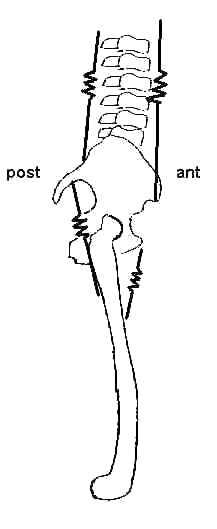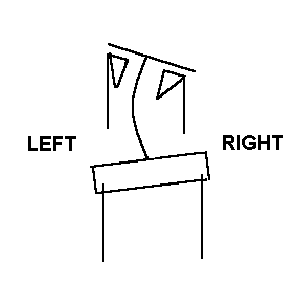- While standing, turn your kneecaps inward, then outward. Notice how rotating the lower extremity affects the subtalar joint's alignment in a closed chain:
- tibial internal rotation -> flattening of arch -> subtalar pronation
- tibial external rotation -> raising of arch -> subtalar supination
Notice how rotating tibia with respect to the femur affects knee motion, including the screw-home mechanism:
- tibial internal rotation -> reversal of screw-home mechanism -> knee flexion
- tibial external rotation -> screw-home mechanism ->
knee extension
- You can produce similar sets of complementary lower extremity movements by moving the pelvis in the transverse plane. While standing with weight on both feet, "twist" so that:
- the right side of pelvis moves forward and
- the left side of pelvis moves backward.
Notice how, in the RLE:
the knee flexes with relative tibial internal rotation and subtalar pronation
While in the LLE:
the knee extends with relative tibial external rotation and subtalar supination
Moving the pelvis in the sagittal plane, while standing with the legs fixed, also requires complementary movements in the hip joints and the lumbar spine.

Frontal plane alignment
If the pelvis is not level in the frontal plane, postural compensations are necessary to maintain alignment of the body's center of gravity over the base of support.
- tibial internal rotation -> flattening of arch -> subtalar pronation
- tibial external rotation -> raising of arch -> subtalar supination
Notice how rotating tibia with respect to the femur affects knee motion, including the screw-home mechanism:
- tibial internal rotation -> reversal of screw-home mechanism -> knee flexion
- tibial external rotation -> screw-home mechanism -> knee extension
- the right side of pelvis moves forward and
- the left side of pelvis moves backward.
Notice how, in the RLE:
While in the LLE:
Moving the pelvis in the sagittal plane, while standing with the legs fixed, also requires complementary movements in the hip joints and the lumbar spine.

|
|---|
